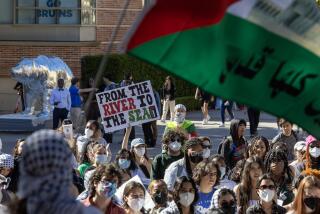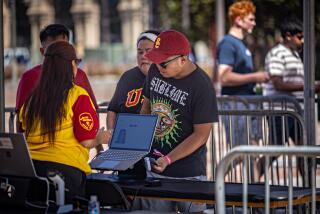A long-hidden mural is revealed, along with a piece of UCLA history
As an undergraduate at UCLA in the 1970s, Helen Singleton often visited the student union building to see a mural she and six other students painted on a wall as a tribute to African American history.
The artwork was a sepia-toned collage and a self-portrait of sorts, showing eight people staring at the interior of Ackerman Union, their faces and hair made up of small images of famous African Americans.
After graduating in 1974, Singleton took a job on campus with UCLA Extension and over the years occasionally stopped at the mural to look at the artwork and think about her classmates.
Then one day in 1992, the mural was gone. A beige wall stood in its place.
“I was devastated,” said Singleton, who was a 37-year-old mother when she helped create the mural in 1970.
Singleton, now 81, was afraid the artwork had been painted over. But a few phone calls revealed that a wall had been placed in front of the mural and that it was probably still intact.
“We wanted to get it out” from behind the wall, she recalls. “But nobody was sure how to.”
So the mural remained behind the wall, leaving generations of students unaware of a slice of UCLA history connecting the school to the activism of the Vietnam War era and, in particular, the nation’s civil rights struggle.
The idea for the artwork was born of a violent campus protest on May 5, 1970, one day after Ohio National Guardsmen killed four students and wounded nine others protesting the war at Kent State University. The killings set off demonstrations across the country.
The Times described the UCLA protest as “a window smashing march through the Westwood campus.” It prompted university officials to declare the first state of emergency in the school’s history. More than 70 were arrested, and a dozen students and 10 police officers were injured in clashes.
Singleton was against the war but didn’t participate in the protests. She had to care for her young children. But when she heard that other art students were discussing ways to respond, she joined in.
The students knew that the UCLA administration was planning to repaint parts of Ackerman, and they persuaded administrators to give them $300 to put a mural on an interior wall.
The seven began by having their photo taken, including an eighth person needed to fill out the frame. They then gathered Ebony magazines and books and chose photos of important figures from African American history, including the Rev. Martin Luther King Jr., Muhammad Ali and Angela Davis, a UCLA professor fired in 1969 for her involvement with the Communist and Black Panther parties.
Small images from those photos and many others became a collage filling most of the mural, which measured 10 by 27 feet.
The artwork was covered during a 1992 renovation as an effort to “dress up” the building, said Roy Champawat, director of the Associated Students UCLA, which helped oversee the project. “There was enough consciousness to know not to paint over it,” Champawat said.
Over the years, as the building became home to new chain and student-run restaurants and seating areas, the wall in front of the mural remained undisturbed.
The campus newspaper wrote about the mural in 2010, near the 40th anniversary of the artwork, and several years later, Afrikan Student Union members went to the site to try to catch a glimpse. Crouching by an exit door, they could see a slice of the mural.
“We could only see about five inches, but there was something there,” said Kamilah Moore, the group’s chairwoman.
Moore and others raised funds to help pay to take down the fronting wall. Singleton joined them earlier this year when workers began the task. She put a hand on her chest and exhaled in relief.
“It was still there,” she said.
The mural was dirty and had water damage in places. “It’s what happens when you have people eating nearby,” said Elizabeth Drolet, an assistant conservator at the Natural History Museum of Los Angeles County who worked on the project.
It took Drolet and others several months to finish cleaning and repairing the painting.
The mural was officially unveiled Wednesday night at a ceremony attended by Angela Davis, Singleton and Neville Garrick, another student who had worked on the mural.
Moore, a senior political science major from Leimert Park, said she hoped the display would be a reminder of history to newer generations of students and also help recruit black students to UCLA, where just 3.8% of undergraduates last fall were African American — a percentage critics say is too small.
Singleton said she was happy to see her restored work, but there was one bittersweet note. She and other UCLA staff tried to find others pictured in the mural but could not track them down. Singleton thought that the other four women may have gotten married and changed their last names, making them harder to find.
“I really would like to see them again,” she said. “It’s been a long time.”
More to Read
Sign up for Essential California
The most important California stories and recommendations in your inbox every morning.
You may occasionally receive promotional content from the Los Angeles Times.











